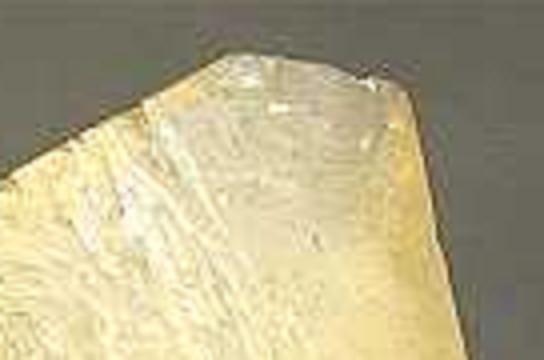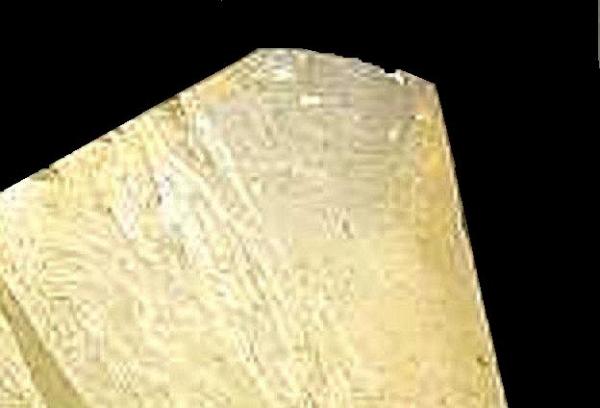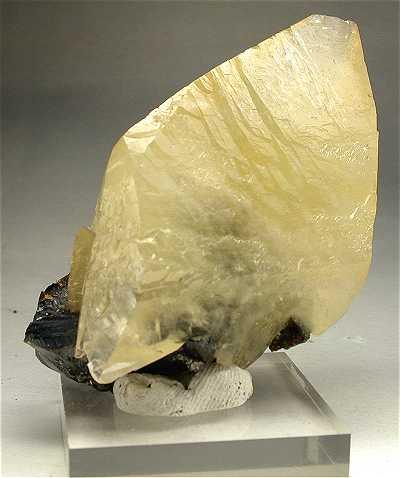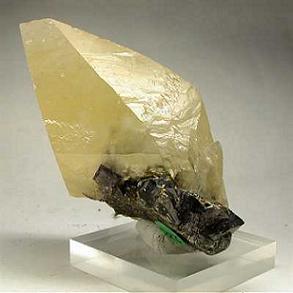| View previous topic :: View next topic |
| Author |
Message |
nurbo
Joined: 23 Sep 2008
Posts: 457
Location: Lancashire



|
 Posted: Aug 31, 2009 03:16 Post subject: What is the definition of 'No Damage'? Posted: Aug 31, 2009 03:16 Post subject: What is the definition of 'No Damage'? |
|
|
Hello
I recently purchased an Elmwood Calcite from an online store, advertised as "No Damage", when I saved the photos (It hasnt arrived yet) to my laptop and magnified them I could see what looked like a tiny chip missing on the termination so I emailed the guy and asked if these were the result of etchings on the Calcite as he had stated it had "No Damage",
This is where I got confused, to cut a long story short the guy admitted there was damage though he never called it damage preferring to call it things like "Small signs from where it was extracted" and telling me I cant expect it to be perfect because Calcite is soft, all sorts of what I regard as pseudonyms for damage,.
I wondered what everyone else thought about this kind of thing? The purveyor of this Calcite is a well respected dealer who has been cited in Min Rec and who's site has received awards, so I would have expected no damage to mean precisely that, the dealers interpretation seems to be that "No Damage" means "No unavoidable during the process of extraction damage", or maybe "No damage other than you would expect on a soft mineral" am I being oversensitive or is the dealer being devious?.
Ive included a zoomed in photo from the advert and one I photoshopped to better bring out the detail,
| Description: |
| From the dealers website zoomed in to 4 times the original size |
|
| Viewed: |
41059 Time(s) |

|
| Description: |
| Photoshopped to enhance detail |
|
| Viewed: |
41076 Time(s) |

|
|
|
| Back to top |
|
 |
John S. White
Site Admin

Joined: 04 Sep 2006
Posts: 1298
Location: Stewartstown, Pennsylvania, USA



|
 Posted: Aug 31, 2009 05:04 Post subject: Re: What is the definition of 'No Damage'? Posted: Aug 31, 2009 05:04 Post subject: Re: What is the definition of 'No Damage'? |
|
|
Looks like damage to me. If tiny nicks occurred during specimen extraction what else can that be but damage? Hundreds, if not thousands, of calcites were collected at Elmwood without suffering "extraction" signs. At least not on the termination of a dominant crystal.
It would be helpful to see a photo of the whole piece and to know the size of the crystal with the nick on it.
_________________
John S. White
aka Rondinaire |
|
| Back to top |
|
 |
nurbo
Joined: 23 Sep 2008
Posts: 457
Location: Lancashire



|
 Posted: Aug 31, 2009 05:19 Post subject: Re: What is the definition of 'No Damage'? Posted: Aug 31, 2009 05:19 Post subject: Re: What is the definition of 'No Damage'? |
|
|
These are from the dealers website, the dimensions given were 75 x 55 x 40 mm
| Description: |
| Back view that caused my concern |
|
| Viewed: |
41053 Time(s) |

|
| Description: |
|
| Viewed: |
41104 Time(s) |

|
|
|
| Back to top |
|
 |
ian jones

Joined: 29 Jul 2009
Posts: 112
Location: london



|
 Posted: Aug 31, 2009 05:42 Post subject: Re: What is the definition of 'No Damage'? Posted: Aug 31, 2009 05:42 Post subject: Re: What is the definition of 'No Damage'? |
|
|
few calcites are totally perfect given the nature of the mineral, but no damage means just that.
if you are unhappy with the piece, send it back saying that it was not as described and that you expect to have the postage refunded too.
|
|
| Back to top |
|
 |
keith
Joined: 26 May 2009
Posts: 32


|
 Posted: Aug 31, 2009 06:21 Post subject: Re: What is the definition of 'No Damage'? Posted: Aug 31, 2009 06:21 Post subject: Re: What is the definition of 'No Damage'? |
|
|
Hi
It should mean just that ... NO DAMAGE.
But ... many dealers indicate .. "no damage " (except on the back and not on the display face) !!!! .... BUT that's still damage !!!!!!!!!!!!!!!!!
Or
No damage ... (visible with a 10x loupe ) ... BUT that's still damage when seen with a 20x loupe !!!!
Or
No damage ... except where it was extracted from the mine !!!
OR
No damage ... apart from on the edges
OR
No damage -- at least not that which detracts !!!!
Let's face it - ALL specimens have some damage somewhere - whether on the edges, on the back, or only visible under magnification. Some dealers are more creative in their descriptions than others but at the end of the day they should be fair and realistic - after all they are trying to sell a product and make money.
As a general rule - there are no "bargains", you pay what for what you get - the more expensive the specimen then you should expect far less faults.
It all comes down to how much "damage" you are prepared to accept .. after all it is your collection.
When you purchase anything over the net and not happy then just send it back. It is not possible to see all angles from a few photos, so you need to confirm that you can send back if not happy.
_________________
Keith |
|
| Back to top |
|
 |
nurbo
Joined: 23 Sep 2008
Posts: 457
Location: Lancashire



|
 Posted: Aug 31, 2009 06:22 Post subject: Re: What is the definition of 'No Damage'? Posted: Aug 31, 2009 06:22 Post subject: Re: What is the definition of 'No Damage'? |
|
|
Its a shame because I love the look of this piece and its the perfect size for my collecting objectives, but I feel there is a principle at stake here and I should send it back simply because it was misadvertised (in my opinion), if the guy had come clean when I mailed him and said sorry, it was a mistake or something and admitted that there was a tiny amount of damage I probably wouldnt be bothered but Ive had several emails where he has simply tried in my opinion to remake the definition of "Damage Free" some rather amusing quotes from his emails ...
"Consider that natural dings are almost common on such large crystals"
"It is in good shape, small signs are usually present in all the calcite crystals from Elmwood mine. Just the hits to take them out from the cavities is able to creates crack or fractures"
" there are 2 really tiny dips, on the upper part of the crystal, almost invisible, probably from the day the crystal was collected !"
"No dings, just small signs"
|
|
| Back to top |
|
 |
John S. White
Site Admin

Joined: 04 Sep 2006
Posts: 1298
Location: Stewartstown, Pennsylvania, USA



|
 Posted: Aug 31, 2009 07:19 Post subject: Re: What is the definition of 'No Damage'? Posted: Aug 31, 2009 07:19 Post subject: Re: What is the definition of 'No Damage'? |
|
|
I think that I would be very reluctant to take this dealer's word in any future transactions. He or she has clearly acted in bad faith in this instance.
_________________
John S. White
aka Rondinaire |
|
| Back to top |
|
 |
Jason
Joined: 31 Dec 2008
Posts: 254
Location: atlanta



|
 Posted: Aug 31, 2009 07:21 Post subject: Re: What is the definition of 'No Damage'? Posted: Aug 31, 2009 07:21 Post subject: Re: What is the definition of 'No Damage'? |
|
|
I have to agree with Keith on this one..with the utmost scrutiny anyone can find some type of damage on just about anything naturally formed..the definition of "no damage" could mean different things to different people..if it was in a display case and I looked at it without seeing any scratches or nicks then i would say "no damage" but if I took my loupe and put the specimen up to it and found the tiniest of scratches could I still then call it "no damage"? In your case nurbo it seems that the nick will be noticable if held in hand at an appreciable distance without giving it the sherlock holmes so in your situation I would say it IS NOT a "no damage" piece. The definition of "no damage", does it apply to etched material? Most of you have seen spodumene that looks so beat up that from a quick glance it looks like it went through the grinder but come to find out all parts are just severly etched..would that be considered no damage??? It wasn't damaged by man but by nature..same with the antero aquas..some come out looking like crap..could you compare an etched aqua from there and a pakistani aqua flawless glass with a tiny scratch towards the bottom? Just by looking at both aquas hand in hand you would swear the antero aqua got dropped but it's only the etching and the nice pakistani aqua..flawless and glass looking perfect hex with the tiny scratch only seen by the closest of eyes at the very base. Does no damage also mean the interior of the stone? back to the aquas as a good example....that sucker is fractured and cracked and included and just plain nasty looking on the inside..easilly seen..just look like a bunch of junk on the inside..but none of the cracks or fractures reaches the outside..could that be considered "no damage"...could you even compare a glass flawlessly clean aqua with a nick on the side to one that looked like an explosion happened on the inside with no visible damage on the outsie whatsoever..what would most people by glance consider the one as "no damage"? (calcite and aqua two totally different things but thought it was a good example I could use). In your case nurbo, just from personal opinion, I would say damaged. If you paid a pretty penny for the item then the utmost scrutiny should be done by the seller but if you paid $100 bucks then sometimes the seller just gives it a quick once over and may miss or not take into account the smallest of things but that is not your problem..you must take the seller at his word. Same type thing used to happen when I collected baseball cards when i was younger..sellers would say "mint condition" but you could always find something whether it be from them or form when the card was made in the factory that you could argue made it not "mint". When you get the calcite pull that puppy out and give it a quick once over and if you spot that nick quickly, even though you know where it's at, send it back. Let us know how this turns out or what you decided to do and maybe throw up a pic or two when you get it. later
jason
|
|
| Back to top |
|
 |
alfredo
Site Admin

Joined: 30 Jan 2008
Posts: 1014



|
 Posted: Aug 31, 2009 07:58 Post subject: Re: What is the definition of 'No Damage'? Posted: Aug 31, 2009 07:58 Post subject: Re: What is the definition of 'No Damage'? |
|
|
| I disagree that "No damage" "means just that - no damage". On the contrary, "no damage" is a meaningless statement in a mineral context, because ALL mineral specimens are damaged - It's just a question of the size of the damage: damage visible to the naked eye of an ordinary person? ...damage visible to the micro-vision of an extremely myopic person like myself? ...damage visible with a loupe? ...damage on the base where the piece was broken out of its host rock? The boundary between acceptable and not acceptable will be highly variable among individuals.
|
|
| Back to top |
|
 |
nurbo
Joined: 23 Sep 2008
Posts: 457
Location: Lancashire



|
 Posted: Aug 31, 2009 08:01 Post subject: Re: What is the definition of 'No Damage'? Posted: Aug 31, 2009 08:01 Post subject: Re: What is the definition of 'No Damage'? |
|
|
Thanks everyone,
Your opinions generally seem to mirror my own, and I doubly agree with John that this guy has acted in bad faith, at no point in the 6 or 7 emails that have passed between us does he say "this piece has no damage" but continually seeks to justify the damage he admits there is as being an acceptabloe amount of damage for a "Damage free" specimen! Which I find confusing. In one email I asked for a simple yes or no answer to wether the piece had no damage or not and received an explanation about oil filling Calcite to hide internal flaws and that this piece hadnt had that done to it. Its the kind of behaviour I'd expect on ebay but not from any reputable dealer.
I appreciate that all crystals are damaged, it depends on how closely you look, but given that does the phrase "damage free" have any meaning other than to attract buyers? Maybe a system like gemologists have for describing gems is required among serious dealers so as to avoid confusion. and bad feeling.
I will post pictures as soon as the piece arrives and I will let you know what I decide to do with it, its a bit complex as I also purchased another piece which is fine (I hope) in the same order..
|
|
| Back to top |
|
 |
Peter Megaw
Site Admin

Joined: 13 Jan 2007
Posts: 975
Location: Tucson, Arizona



|
 Posted: Aug 31, 2009 09:22 Post subject: Re: What is the definition of 'No Damage'? Posted: Aug 31, 2009 09:22 Post subject: Re: What is the definition of 'No Damage'? |
|
|
I agree with Alfredo..."no damage" is meaningless... as is arguing over any absolute.
However, this entire thread highlights the disconnect inherent in buying minerals through the internet. At a show one can examine a specimen and determine immediately if it satisfies one's taste and standards of "perfection" (even harder to define than no damage). If it doesn't cut it, you put down with a muttered "what a shame, was a great rock before it got bumped" and move on without much further thought. The dealer has not had any input into your decision, nor do you hold the imperfections against him/her.
Its the opposite for internet sales as the dealer has to describe the piece in language that he/she hopes will convey the specimen's condition AND make a sale that sticks. I find that the process of deciding to buy a specimen off the internet tends to invest significant anticipation (and hope) into the purchase that is frequently dashed when the piece arrives (depending a LOT on the dealer of course). Damage, color, crystal size and clarity often do not live up to expectations and the piece goes back...and a tiny demerit, consciously or unconsciously,lodges in the brain against the dealer. Enough demerits and one begins to wonder about ordering from the dealer again.
Given the pickiness of many collectors (myself included) it amazes me that ANY internet sales stick, so it must be a testament to some dealers clarity of expression...or quality of specimens...that they get routine repeat customers. Might be interesting to review the internet dealers you routinely buy from (as in actually keeping the specimens) versus those you routinely return pieces to, and compare the descriptive language used.
_________________
Siempre Adelante! |
|
| Back to top |
|
 |
alfredo
Site Admin

Joined: 30 Jan 2008
Posts: 1014



|
 Posted: Aug 31, 2009 09:49 Post subject: Re: What is the definition of 'No Damage'? Posted: Aug 31, 2009 09:49 Post subject: Re: What is the definition of 'No Damage'? |
|
|
| When internet selling of minerals first became popular in the 1990s, I heard a couple of the then budding new internet dealers arrogantly proclaim that the internet was going to make mineral shows obsolete, and soon drive shows into extinction! Peter has just given a very well-written explanation of why this hasn't happened, and probably won't. Precisely why I mostly buy at shows, and very rarely over the internet.
|
|
| Back to top |
|
 |
ian jones

Joined: 29 Jul 2009
Posts: 112
Location: london



|
 Posted: Aug 31, 2009 10:39 Post subject: Re: What is the definition of 'No Damage'? Posted: Aug 31, 2009 10:39 Post subject: Re: What is the definition of 'No Damage'? |
|
|
We may be getting a bit pedantic here.
Agree that "no damage" in specimen terms cannot be an absolute and it rather depends on what you are prepared to accept on a specimen in your collection. And obviously, most people will usually accept more damage on a self-collected piece than on a bought one!
Getting away from arguments about whether internal fractures etc. formed prior to collection are damage, ditto attachments, then at the least, if you can see nicks and chips on the face and edges with the naked eye, that is surely damage. It might be trivial enough for most of us to live with, but it is still damage.
I rarely buy off the internet for my collection unless it is a locality piece that I particularly want to fill a gap. I do not buy display pieces as, regardless of damage or the lack of it, I want to be able to hold it, turn it around, and generally just see if it "speaks" to me. That's why shows win every time.
My own, albeit limited, experience of internet buying is, like Peter, that things also never seem quite as good when you get them. And they often shrink in the post too! Probably the reason more things don't get returned is a mixture of apathy and, as most dealers realise, most of us aren't absolute perfectionists.
|
|
| Back to top |
|
 |
nurbo
Joined: 23 Sep 2008
Posts: 457
Location: Lancashire



|
 Posted: Aug 31, 2009 12:19 Post subject: Re: What is the definition of 'No Damage'? Posted: Aug 31, 2009 12:19 Post subject: Re: What is the definition of 'No Damage'? |
|
|
I guess the thing that annoyed me the most is that in this case the dealer clearly was aware that there were visible "Small signs" as he chose to call them but didnt mention this in the advert, Im not actually bothered if there is a small amount of damage that is mostly difficult to see, but, I noticed it from a low resolution photograph and upon emailing the guy he knew exactly which marks I was asking about.
My personal belief is that "Damage Free" means no obvious damage to the naked eye, if I notice it enough to make me feel the need to further investigate it then the piece should never be classed as "Damage Free",
I agree with Pete and Alfredo to a certain extent that "Damage free" is meaningless, but I also think that it isnt up to me which terms people use to describe what they sell so the term cannot be discontinued from popular usage, therefore a consensus should be reached to determine just what is meant by "Damage Free". Everyone is familiar with the different sizes of specimen, micro mount or large cabinet, whatever, so a similar consensus on iterations of damage would I think help everyone, and possibly even boost online sales, since people who avoid online purchases because they dont trust the descriptions would know exactly where they stand.
|
|
| Back to top |
|
 |
GneissWare

Joined: 07 Mar 2008
Posts: 1287
Location: California



|
 Posted: Aug 31, 2009 12:49 Post subject: Re: What is the definition of 'No Damage'? Posted: Aug 31, 2009 12:49 Post subject: Re: What is the definition of 'No Damage'? |
|
|
I expect that "No damage" should mean "no damage that is visible to the naked eye". If you can see it in the photo, it should have been described, unless the dealer just didn't see it, which sometimes happens. As the amount of damage usually translates into a lower price, if you paid a fair price for it with the damage, then you probably got a fair deal. If it was priced as "undamaged", then the dealer should make it right -- either by discounting it or accepting return including your shipping costs both ways. If he doesn't then you know you shouldn't buy from them again.
I know everyone can make an honest mistake. Sometimes, particularly at my age, I just don't see the damage on a specimen. But, if the customer doesn't like it they can always return it. And, if I messed up, and they still want the piece, I'll always try to make the deal work. Most dealers I know work like that. Those that don't, I just don't buy from them.
|
|
| Back to top |
|
 |
|




